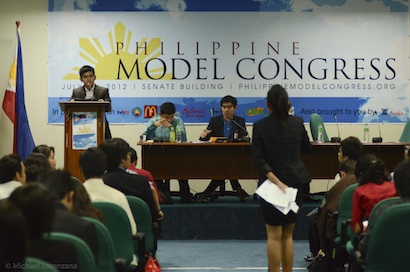SUMMARY
This is AI generated summarization, which may have errors. For context, always refer to the full article.
 When I agreed to help organize the 1st Philippine Model Congress (PMC), I really had no idea what I was getting myself into. At that time, I was trying to figure out what project I could start to give back to the nation.
When I agreed to help organize the 1st Philippine Model Congress (PMC), I really had no idea what I was getting myself into. At that time, I was trying to figure out what project I could start to give back to the nation.
Then, Leandro pitched the idea of organizing a national youth conference for 300 students where they would create their own bills and debate them, just like Congress. He wanted to do it from scratch, and he wanted to do it in 6 weeks’ time. He wanted to start it and I wanted to start something, so I thought we could make something out of it.
Since Leandro and I weren’t very close then, I was flattered that he had thought of me. Inasmuch as I thought it was a great idea, it was a political conference, which wasn’t really along the same road as my other interests. I told him I’d make the poster, but I wasn’t sure how much more I could contribute. After all, I was a fulltime student, while he and some of the other friends he had helping him out, were on vacation.
I met with Leandro, Thomas (one of his friends), and Tricia (one of mine) one Monday night in Starbucks where we poured over every imaginable detail of the conference that we could think of.
We were engrossed in work and driven by pure passion and a desire to convert our pent-up energies into something productive. Later on, Alonzo (another of Lean’s friends) joined our team. The way the 5 of us worked together, you would never have guessed that half of us had known each other for less than a month only.
Model Congresses are commonplace in the United States, where top tier universities organize annual conferences for high school students. Here, the closest thing to it is the National Youth Parliament. However, it lasts a lot longer and they take a lot less participants.
We decided that we wanted to make something similar, but more inclusive to give all youths an opportunity to express their views because we believed that every opinion was valuable and deserved to be heard.
Six weeks passed by very quickly. Aside from the poster I promised to make, I also found myself handling marketing, website design, parts of the online registration process, and logistics. A few days after meeting with about 8 different Senate directors to coordinate the logistics of the event, we were ready to open the doors of the Senate to the youths of the nation.
We had no idea what to expect, but I don’t think we couldn’t have been more surprised.

Passionate debates
Call-time for the event was at 8:00 am. But in this country, as my Lebanese friend aptly puts it, time is a suggestion. Normally that means people come an hour late. That day, however, people came two hours early.
By 7:00 am, more than half of the participants were already there. When you’re a team of 4, along with a handful of volunteers, all of whom have never organized something of this level, managing registration for more than a hundred people an hour before they were supposed to come is not easy. The team managed, and an hour later, we proceeded to the event proper.
Inside the main hall, I saw an unusual sight – 400 teenagers up early on a Saturday morning, all dressed up to play congressman. In the morning, we had Valenzuela Rep Rex Gatchalian give a primer on Congress, while former Sen Richard Gordon gave a keynote address that centered on volunteerism.
Later that day, Rappler’s Maria Ressa gave another speech that centered on social media after lunch. All were very well received, something evident from the long lines behind the microphones at the open forum.

When we began conceptualizing PMC, we thought that one of the biggest problems we’d face was that nobody would want to write their own bills. Thank God we were wrong. We received an overwhelming number of bills, including interesting ones, which proposed an online entrepreneurial platform and a revitalized NSTP program.
Although the debates at the committee level were driven by passion, it was the debates during plenary that brought the house down.
Apathetic youth?
Since we were short on time, we decided that instead of debating the bills that were passed in the committees, we would briefly tackle current divisive issues and then put them up to a vote in order to make an official stand, which we would send to Speaker Sonny Belmonte.
As highly controversial issues began to take centerstage, the crowd became louder as the chosen speakers rode on their momentum. It was thrilling to see that the so-called apathetic youth weren’t so apathetic after all.
At some point in time, however, I questioned why I was doing all of this. After all, PMC was meant to encourage people to run for Congress someday, which I personally had no plans of doing.
But as we began to tackle the issues and began proposing solutions, I realized that even if this was a simulation of a day in public office, it was by no means just that. By focusing on the plethora of solutions for existing problems, instead of the politicking, the event was able to highlight the value behind entering public service.
While politics and public office have never piqued my interest, public service definitely has. However, I don’t think public service is limited to simply working for a government department or agency. I’ve always seen it as the performance of your individual duties for the betterment of your country – whether it be through traditional avenues like government or the military, or through contemporary ways like social entrepreneurship programs, charity work, or even events-organizing like PMC.
That’s a message that resonated with the hearts and minds of the 400 delegates who came that day. As Leandro put it in his opening remarks, the conference might have been a simulation, but the effects were definitely real.
And more than the official youth stand we came up with that day, I think this is what matters the most. – Rappler.com
Add a comment
How does this make you feel?
There are no comments yet. Add your comment to start the conversation.